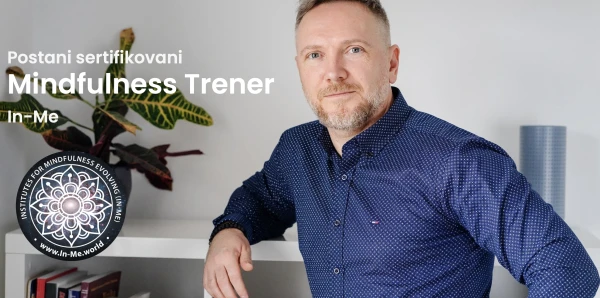About Us / Resources / Material
Parts Party from Virginia Satir - English Version
About Us / Resources / Material

Dr. Darko Cvetković
"Mindfulness Trainer, In-Me" training by trainer Dr. Darko Cvetković in Online Training
Read more- The original step by step instructions for the Parts Party of Virginia Satir
- The step by step instructions for the Parts Party from Robert McDonald
- The SySt form of Parts Party from Virginia Satir according to Systemic Structure Constellation (SySt) by Insa Sparrer
- The Social Panorama version of Parts Party oriented at Virginia Satir and SySt
1. Prepare the Guide and Host for the party.
a. Identify the Host's parts in terms of famous people.
b. Select adjectives for them.
c. Categorize these adjectives.
d. Select role-players.
2. Have the parts meet each other.
a. Initiate the party by having the parts meet and interact.
b. Have the parts freeze and then identify their feelings.
c. Verify these with the Host.
d. As they resume interacting , have the parts feelings. exaggerate their expression of subsequent
e. Have them freeze again and identify these feelings.
f. Verify them with the Host.
3. Develop a conflict.
a. Have the parts try to shape the party in their own image.
b. Have one part dominate the party.
c. Have all the parts freeze and identify their feelings.
d. Verify with the Host.
4. Transform the conflict.
a. Have the parts interact and achieve cooperation.
b. Have them build harmony with each other.
c. Have them accept each other.
d. Verify this process with the Host.
5. Perform the integration ritual.
a. Have each part present its many resources and transformations.
b. Have each part ask the Host for acceptance.
c. Have the Host accept and integrate all the parts.
d. Have the Host take charge of these parts with new choices and new energy.
- With your eyes closed, imagine being in a place in nature where you feel very comfortable. And, while exploring this place in nature, notice a rectangular table with six chairs around it.
- Ask your unconscious mind for two parts of yourself which you really enjoy. And when they arrive, welcome them, as they take their seats at the table. Introduce them to each other.
- Ask your unconscious mind for two parts of yourself which you find useful and practical in some way. And when they arrive, welcome them, as they take their seats at the table, then introduce everyone there.
- Ask your unconscious mind for two parts of yourself which you particularly dislike. And when they arrive, welcome them, as they take their seats at the table, then introduce every one there.
- Say to all the parts at the table, “Please tell me who here feels the most misunderstood?” Notice which one responds. And now ask the one who feels most misunderstood, “What is your positive purpose, the gift you bring to me?” Listen to the answer. And notice that the others understand and appreciate the importance of this part’s gift.
- Say to the remaining five parts, “Who among you feels the most misunderstood?” And ask the one who responds, “What is your positive purpose, the gift you bring to me?” Listen to the answer. And notice that the others understand and appreciate the importance of this part’s gift.
- Say to the remaining four parts, “Who among you feels the most misunderstood?” And ask the one who responds, “What is your positive purpose, the gift you bring to me?” Listen to the answer. And notice that the others understand and appreciate the importance of this part’s gift.
- Say to the remaining three parts, “Who among you feels the most misunderstood?” And ask the one who responds, “What is your positive purpose, the gift you bring to me?” Listen to the answer. And notice that the others understand and appreciate the importance of this part’s gift.
- Say to the remaining two parts, “I’ve welcomed the other parts to this table; I’d like to welcome you, as well. Please tell me, one at a time, the gift you bring to me.” Listen to their answers. And notice that the others understand and appreciate the importance of the gifts these parts bring.
- Watch as the six parts create a circle of gifts by holding hands with each other. And, as the table fades away, stand in the middle of the circle of gifts, and allow this inner-team, to merge in the centre of your heart, breathing it into your lungs, your bones and blood stream.
- And now I’ll touch the base of your throat to anchor this new integration. And you can let the feeling you have now, as I touch your throat, take you all the way into your past, to just before you were born. Be in your mother’s womb feeling this way. And as both sperm and egg, allow yourself to continue going back into all the branches of your family history. And now, with this integrated feeling deeply within your history, your body and your cellular structure, gently bring it forward through all the branches of your family and years of your life to this present moment. Now, watch it continue to gently unfold into your future.
- As I let go of the throat-anchor, notice what your life will feel like from now on with this integration totally within you.
The constellator or trainer directs the constellation.
The host looks inward and goes through the following steps:
- Look inside you for 6 parts that you want to work with. Take 3 parts that you find attractive and maximal up to 3 parts that you do not like. If a part that you do not like is very strong, make shure that you have enough strong positive parts to handle this. In this case you can e.g. as well chose 1 part that you do not like and 3 parts that you find attractive. Give the parts names of public figures such as: actors, politicians, or writers, or names of e.g. animals, mythical creatures, or fairy tale characters. Do not choose anyone you know personally, e.g. from your circle of acquaintances, family, colleagues, friends, etc.
- Choose a characteristic or quality for each person.
- Choose a typical sentence, gesture, and way of walking for each person.
- Choose a representative from the group for each person. These representatives are called party guests. Give each party guest the name, the typical sentence, a gesture and a way of walking.
Three scenes now follow one after the other. The trainer gives the party guests the task of dressing up for the scenes. All party guests step onto the “stage” and follow the trainer's explanations. For each scene, the party guests go to the “stage” twice.
First scene: All party guests have the task of getting to know each other. Everyone is only allowed to say their sentence, make their gesture and use their way of walking. The task is: "Greet the other guests!"After a certain time, the trainer interrupts the performance and asks everyone about their impressions and feelings.Everyone goes back and meets the party guests they haven't met yet.
Second scene: Everyone tries with his sentence, his gesture and the way he moves to create a stressful situation and to dominate the party.After a certain time, the trainer interrupts the performance and asks everyone about their impressions and feelings.Everyone goes back and continues to play this scene for as long as the trainer deems appropriate. The trainer asks several times.
Third scene: Getting in contact with each other. The sentence specified at the beginning can now be changed.After a certain time, the trainer interrupts the performance and asks everyone about their impressions and feelings.Everyone goes back and continues to play this scene as long as the trainer deems it appropriate. The trainer asks several times.
Integration ritual: The host goes on the “stage”. The party guests stand around him. One by one, each party guest puts a hand on the host's back and tells him what skill he is giving him. The host integrates all of these skills. Then everyone leaves the stage.
ExchangeThe trainer asks the host, the party guests and the audience about their own experiences.
Through the process of the 3 scenes, the party guests experienced a transformation process through their experience and inner perception. In doing so, they connected themselves with productive skills and passed these on to the host.
In the video, Insa Sparrer explains the similarities between the approaches of SySt (Systemic Structure Constellation) and the work of Virginia Satir. Both approaches do not exclude any part. All parts go through a transformation process and are then integrated by the host. The humor that pops up during the party is intended by Virginia Satir. The disguise, the limited script, the exaggerations - the parts are not that pointed. The process is fun and that's how it is meant to be. You can solve something easily and playfully. That is the power of this method.
The very special options and benefits of the Social Panoramas approach are
- it does not need any physical representatives (outside the brain)
- it is done directly with the client without any other persons needed
- it can use NLP submodalities in the inner mental space of the client
- you are more free and flexible with the numbers of invited parts
- at any time an additional part can easily be invited if required
This way any bias distortion through representatives cannot occur and it is much faster and elegant. In the following description, we use as basis the approach of the Systemic Structure Constellation (SySt) from Insa Sparrer and apply to this process the benefits of the Social Panoramas approach.
The Social Panorama constellator or trainer directs the constellation.
The client (or host) is asked to look inward and to go through the following steps:
- Invite in your inner mental space up to 6 parts that you want to work with. Invite 3 parts that you find attractive and 1 to 3 parts that you find challenging (that you do not like). Make sure that the energy of the attracting parts is higher than the energy of the parts that you do not like. Invite them to appear in your inner mental space (your social panorama) as public figures such as: actors, politicians, or writers, or names of e.g. animals, mythical creatures, or fairy tale characters. Do not choose anyone you know personally, e.g. from your circle of acquaintances, family, colleagues, friends, etc.
- Explore each part in your mental space: Where does each part appear within your mental space? Is he before you or on your right or left side or behind you? What is his very special characteristic or quality? What is a typical sentence, gesture, and way of walking? Is he taller or smaller than the other guests around him? In which direction does he look? Is he in a lighter or darker area than the others?
- Each part is now a party guest in the inner mental space of the client who is the host.
Now follow three scenes one after the other.
First scene: All party guests have the task of getting to know each other.Everyone is only allowed to say their sentence, make their gesture and use their way of walking. The task is: "Greet the other guests!"After a certain time, the Social Panorama constellator asks the client to ask every party guest about his impressions and feelings.If any parts have not meet yet then this part of the party is continued until all have met and the client has reported their impressions and how they feel.
Second scene: Everyone tries with his sentence, his gesture and the way he moves to create a stressful situation and to dominate the party.After a certain time, the Social Panorama constellator asks the client to ask every party guest about his impressions and feelings.If any parts have not tried to create a stressful situation and to dominate the party yet, then this part of the party is continued until all have tried and the client has reported their impressions and how they feel.
Third scene: Getting in contact with each other.The sentence specified at the beginning can now be changed.After a certain time, the Social Panorama constellator asks the client to ask every party guest about his impressions and feelings.If any contacts are still open, then this part of the party is continued until all have contacted and the client has reported their impressions and how they feel.
Fourth scene: Finding a sustainable system ecological solution.The Social Panorama constellation asks the client to find ways how all parts can coexist without conflict among each other.After a certain time, the Social Panorama constellator asks the client to ask every party guest about his impressions, feelings and needs to coexist with the others without conflict.If any contacts are still not feeling good, then this part of the party is continued until all can coexist without conflict among each other.For this final process Social Panorama uses e.g. changing the place where each party guest is standing, changing the surrounding light, voice tone, size and many more helpful submodalities.
Fifth scene: Integration ritual.The party guests stand in the mental space of the client around him. One by one, each party guest puts a hand on the client’s back and tells him what skill he is giving him. The client integrates all of these skills. Then he thanks every party guest.
The Social Panorama approach is rooted in NLP principles:
- The NLP principle that it is neither ecologically nor ethically justifiable to forego personality components also applies to personifications. They are retained. Parts of our mental hard drive are not deleted. You can change it or improve it.
- We have social submodalities and idiosyncratic submodalities (idiosyncratic is not fixed, people can call up different reactions that cannot be predicted). Submodalities can be changed. Check the ecological aspects when such changes happen: “What can happen when I look at the social world in this way? What can I lose by doing this? What problems can develop? Are there any undesirable side effects when I look at people from this perspective?"
- The client experiences his selected personifications at his Parts Party. This Parts Party is designed like an allegory. The personifications are public figures, with typical gestures, attributes, phrase, and ways of moving. The personifications are not as exaggerated as they appear in the actual performance.
During the Parts Party submodalities can be changed deliberately for reaching good results:
- The client (host of the Parts Party) is part of the Social Panorama and his guests are around him. The relationship is a localization. We can directly see the relationship that the client (host) has with each of the parts.
- Typical submodalities: left/right, above/below. in front/behind, distant/close, large/small.
- Well-formedness is important in the Social Panorama. Emotions are very important. Everyone belongs to the family. Everyone must be content with his place within the Social Panorama.

Dr. Darko Cvetković
"Mindfulness Trainer, In-Me" training by trainer Dr. Darko Cvetković in Online Training
Read more

